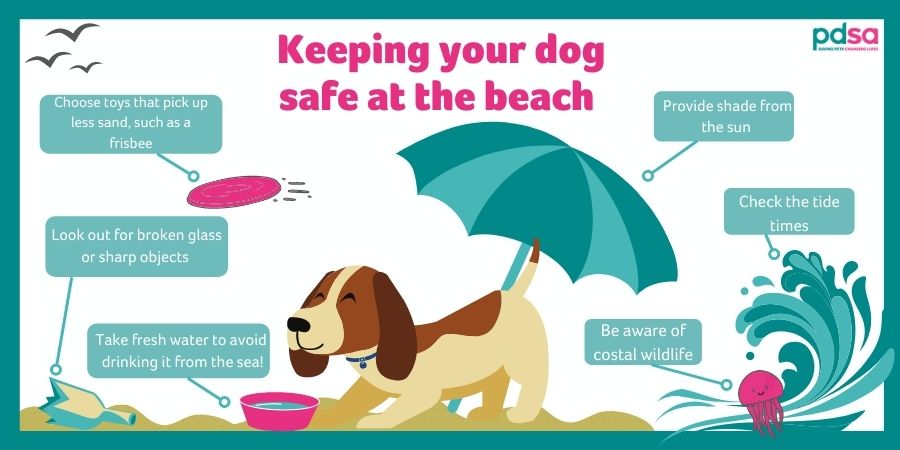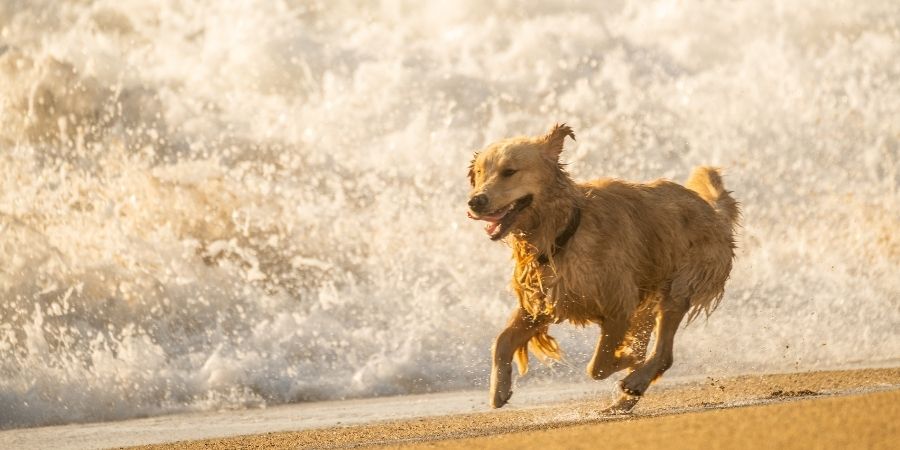1. Check that the beach is dog friendly
Before you head out to any beach, always check whether dogs are welcome first. Some beaches only allow doggies at specific times of the year or in certain areas. You can find out whether the beach you’re planning to visit is dog friendly by looking online or by checking for signs when you arrive.
Just like any other dog walk, always clean up and remove the waste after your pup – dog friendly beaches often have poo bins readily available to keep the beach clean, safe and enjoyable for everyone!
2. Be aware of beach hazards
A day at the beach with your four-legged friend is the perfect fun day out – however, there are a few hazards that have the potential to dampen the day. It’s always best to be aware of them, so you can keep your pooch safe.

Keep cool
While the weather might feel cooler in the sea breeze, don’t forget that temperatures can still quickly soar – especially in the summer months. Always protect your pup from heatstroke by making sure they have a good area of shade to sit in and fresh water to drink – you can even try making your own DIY sun shelter while out and about!
In the height of summer, avoid visiting the beach during the hottest part of the day – early mornings and later on in the evenings are best, as the temperatures tend to be cooler. Also be ready to head home when your pooch has had enough!
Broken glass or sharp objects
Broken glass or sharp objects that can be hidden in the sand or amongst pebbles, can cut the pad of your dog’s paw if stepped on. Make sure you keep a first aid kit handy and keep an eye out for hazards that might cause an injury. If your dog is unlucky enough to get a cut, make sure you keep it clean by washing it well with fresh water and try to cover the wound, before taking a trip to the vet.
Sand
Believe it or not, eating and swallowing sand can actually cause stomach problems for your dog, as the sand can compact in their tummy and cause a blockage.
When throwing toys for your pooch on the beach, be careful that they’re not accidently swallowing lots of sand as they’re playing. Choosing toys that pick up less sand – a Frisbee rather than a fuzzy beach ball, for example – and discouraging your dog from eating or chewing the sand while they dig or play, can help prevent the risk.
Seawater
Drinking salty sea water can give your dog a nasty bout of sickness and/or diarrhoea – and in some cases can make them seriously ill and dehydrated. Always take plenty of fresh tap water, along with a travel bowl to stop your pooch from being tempted to drink water from rock pools, puddles or the sea.
If your dog's been in for a dip, give them a rinse with fresh water when you get home to prevent them licking any salt from their fur – and don’t forget to clean their ears, as water in the ear canal can cause infections to brew.

3. Be cautious when sea swimming
Swimming is a great exercise for dogs and can help them cool down on a hot day. Most of the time it's a safe, fun activity for your pooch – but it's important to be aware of the dangers that can come with sea swimming, whilst knowing what to do in an emergency.
Always remember that not all dogs are natural swimmers – some doggies can be scared of the waves! Never force your dog into the sea, let them decide if they want to take a dip or whether they’d rather stay with all four paws firmly on dry land.
If your dog is eager to dive in but they’ve not had any experience swimming, they'll need to get the hang of how to swim before taking a plunge in the ocean. With waves and currents, the sea isn’t the best place for them to take their first dip and they’ll need to learn to swim in shallow, calm water.
Regardless of whether your dog is a strong swimmer, the sea can still be unpredictable. There are lots of strong currents, undertows and rip currents, and even a calm looking sea can have hidden dangers. It doesn’t mean you shouldn’t let you dog swim, but it’s always best to take precautions to help keep them safe:
- Read up about currents ahead of time – there are lots of websites designed for swimmers which will discuss safe swimming spots and areas that might have dangerous or strong currents. These can be helpful for you to find a safe swimming spot for your dog.
- When you arrive, check whether the beach has a lifeguard on duty – lifeguards are professionals, there to keep you and your dog safe.
- Pay attention to signs or flags warning you not to swim – a red flag or a sign showing a white circle with a red line through it means you shouldn’t swim – and neither should your dog!
- If the sea looks dangerous, don’t let your dog swim – if the waves are very big, or you know that the tide is turning, it’s not suitable for your pup.
- Don’t let your pup swim in the sea if it’s very cold – dogs can struggle when swimming in very cold water!
- Don’t forget to check the tide! Before you head to the beach, make sure that you have checked the tide times. Regardless of whether your pooch is planning to take a dip in the sea, you don’t want to be cut off by the tide!
What to do in an emergency
If your dog does get into trouble, don't go into the water to help them. Call 999 immediately and ask for the coastguard. It’s also a good idea to continue calling your dog from the shore – this will give them something to swim towards if they get disorientated in the waves. While it’s natural to want to protect your dog, going into the water could put your life in danger and could confuse your dog as they aren’t able to find you on the shore. Staying on the beach will help your dog to keep swimming in the right direction and mean the coastguard can focus on rescuing them instead of you.
4. Take extra care on clifftop walkies
Britain's coast is famous for its beautiful cliff spots, which are enjoyed all year round. They can provide a wonderful, rugged walk for you and your pooch, however it’s always important to pay extra attention if you're walking your dog near a cliff.
Always look out for signs warning you about crumbling cliff edges and stick to the path. It's a good idea to keep your dog on a close lead. Not only will this stop them from chasing something that could take them dangerously near the edge, it will also provide extra protection against strong gusts of wind or slippy rocks that could unbalance them. Just make sure you stay sure footed yourself and your dog has been trained not to pull on the lead!

5. Protect your dog from coastal wildlife
Most dog owners know it’s important to stay safe around farm animals and other wildlife, but what about at the beach?
The British seaside is home to all sorts of animals, from birds and barnacles to seals and starfish! Here’s how you can stay safe:
- Birds: Look out for signs asking you to keep out of certain areas – birds that nest on the ground need extra protection, and people are asked to keep away while they're sitting on eggs. Keep your dog on a lead between March and August on these beaches, and in any other areas where you think there might be wildlife, so they can't disturb the birds.
- Seals: If you're in area known for seals, keep your dog on a lead. This is especially important when there are seal pups around – mother seals can be very protective of their babies.
- Jellyfish: Jellyfish can give a nasty sting to both people and dogs, so check the water before swimming and don't let your pooch sniff around washed up jellyfish on the beach – they can still sting, even when they're dead!
- Seaweed: Seaweed can cause a stomach upset if your dog eats too much – and if your dog swallows large stalks it can even cause a gut blockage. Seaweed can also become coated in other substances, such as oil or palm oil from damaged ships, which can be highly toxic. On top of that, it can hide or cover dead fish (or other sea creatures!) that you dog might scavenge, so it’s best avoided as much as possible.
